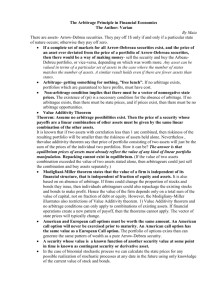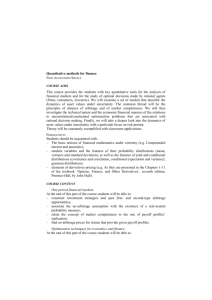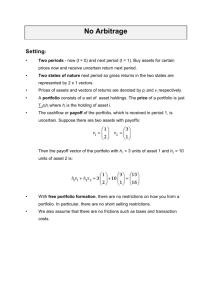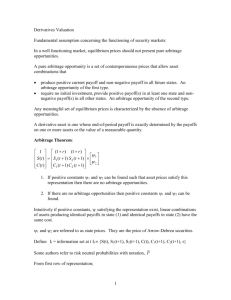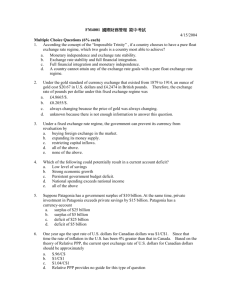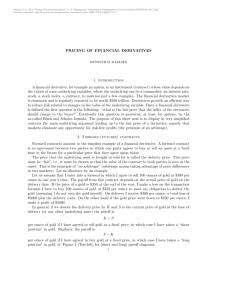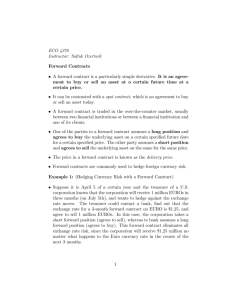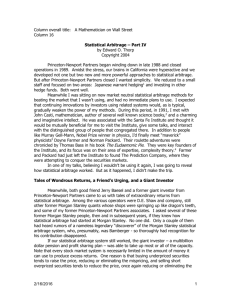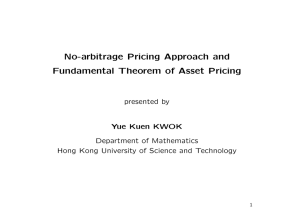Notes 1
advertisement
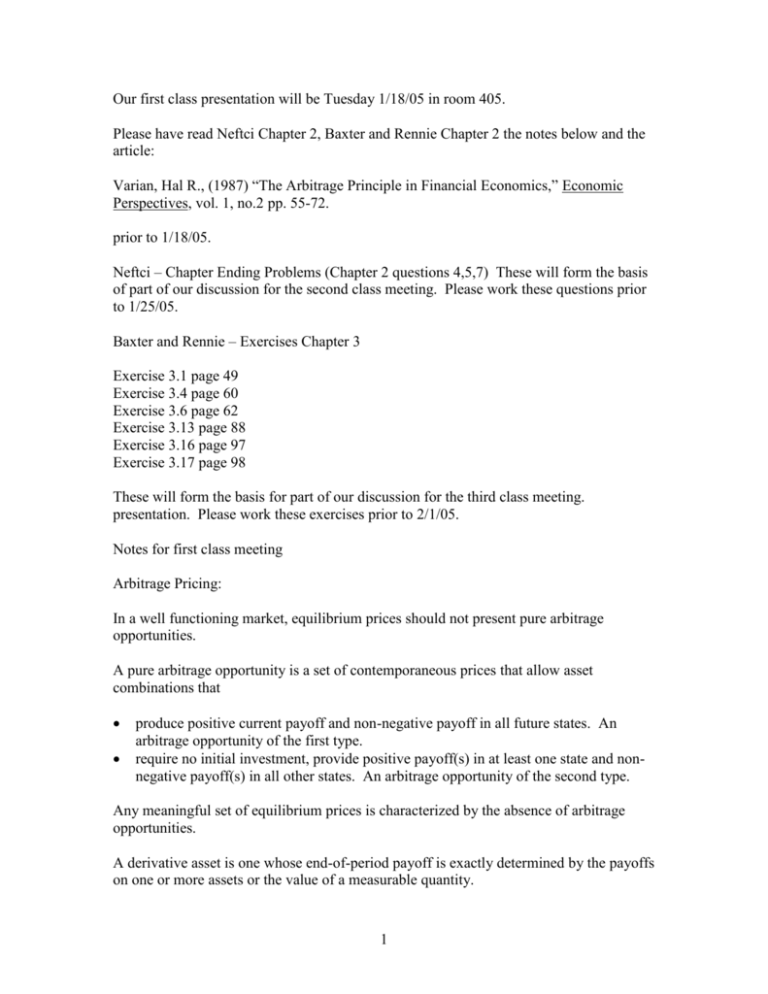
Our first class presentation will be Tuesday 1/18/05 in room 405.
Please have read Neftci Chapter 2, Baxter and Rennie Chapter 2 the notes below and the
article:
Varian, Hal R., (1987) “The Arbitrage Principle in Financial Economics,” Economic
Perspectives, vol. 1, no.2 pp. 55-72.
prior to 1/18/05.
Neftci – Chapter Ending Problems (Chapter 2 questions 4,5,7) These will form the basis
of part of our discussion for the second class meeting. Please work these questions prior
to 1/25/05.
Baxter and Rennie – Exercises Chapter 3
Exercise 3.1 page 49
Exercise 3.4 page 60
Exercise 3.6 page 62
Exercise 3.13 page 88
Exercise 3.16 page 97
Exercise 3.17 page 98
These will form the basis for part of our discussion for the third class meeting.
presentation. Please work these exercises prior to 2/1/05.
Notes for first class meeting
Arbitrage Pricing:
In a well functioning market, equilibrium prices should not present pure arbitrage
opportunities.
A pure arbitrage opportunity is a set of contemporaneous prices that allow asset
combinations that
produce positive current payoff and non-negative payoff in all future states. An
arbitrage opportunity of the first type.
require no initial investment, provide positive payoff(s) in at least one state and nonnegative payoff(s) in all other states. An arbitrage opportunity of the second type.
Any meaningful set of equilibrium prices is characterized by the absence of arbitrage
opportunities.
A derivative asset is one whose end-of-period payoff is exactly determined by the payoffs
on one or more assets or the value of a measurable quantity.
1
Arbitrage Theorem: (Neftci)
1 (1 r ) (1 r )
S (t ) S (t 1) S (t 1) 1
2
1
C (t ) C1 (t 1) C 2 (t 1) 2
1. If positive constants 1 and 2 can be found such that asset prices satisfy this
representation then there are no arbitrage opportunities.
2. If there are no arbitrage opportunities then positive constants 1 and 2 can be
found.
Intuitively if positive constants, , satisfying the representation exist, linear combinations
of assets producing identical payoffs in state (1) and identical payoffs in state (2) have the
same cost.
1 and 2 are referred to as state prices. The are the price of Arrow-Debreu securities.
Define: It = information set at t It {S(t), C(t), r}
~
Neftci refers to risk neutral probabilities with notation, P
From first row of representation;
~ ~
1 = (1+r)1 + (1+r)2 or 1 = P1 P2 , i.e. risk neutral probabilities sum to one. Risk
neutral probabilities equal the product of the future value factor, (1+r), and the state
prices i .
From second row of representation;
St = S11 +S22 then multiplying by (1+r)/(1+r)
~
~
~
~
~
St = (1/(1+r))[ P1 S1 + P2 S2] = P1 (S1/(1+r)) + P2 (S2/(1+r)) = (1/(1+r))* E P [St+1]
~
~
~
~
~
Ct = (1/(1+r))[ P1 C1 + P2 C2] = P1 (C1/(1+r)) + P2 (C2/(1+r)) = (1/(1+r))* E P [Ct+1]
Expectations calculated with the risk neutral probabilities and discounted at the risk free
rate equal the current values of the assets.
A martingale is a stochastic process such that;
EtP X t s I t X t
~
2
Using the risk neutral probability measure the expectation of the normalized future price
is equal to the current price, i.e. the risk neutral probability measure converts normalized
asset prices to a martingale processes.
Define X t s
Sts
1 r s
From the representation if we define B(t) = 1, then Bt+s=(1+r)s , represents the
accumulation in a money market account earning r per period. Notice that it is the
normalized asset value (ratio of S/B) that behaves like a martingale.
~S
~ C
St
C
E P t s or more to the point of derivative pricing, t E P t s
1
1
Bt s
Bt s
No arbitrage condition; (Simple 3 security, two-state representation)
S (t 1)
S (t 1)
Define gross return on S in states (1,2); R1 (t 1) 1
R2 (t 1) 2
St
St
Then from the first and second row of the representation;
1 = (1+r)1 + (1+r)2
1 = R11 + R22
Subtracting one from the other;
0 = [(1+r)-R1] 1 + [(1+r)-R2] 2
if I > 0 then
R1 < (1+r) < R2
With no payouts the arbitrage theorem states that the risk neutral probability measure
produces expected return (1+r) for all asset prices. If an asset has a known positive
payout the expected return under the risk neutral measure is reduced by the size of the
payout.
An example:
A stock with current value $50 will have value of either $50 or $60 at the end of one
year. The risk free rate is 10% per annum. The arbitrage free price of a European call
option with exercise price of $55 and time to expiration is Ct = $2.273.
3
1 1.1 1.1
50 50 60 1
C (t ) 0 5 2
If C(t) = $1, positive constants satisfying the representation do not exist and arbitrage
opportunities are possible.
From the third row of the representation, 2 = 1/5 = 5/25.
Given 2 = 1/5, the second row implies that 1 = 19/25
These obviously do not satisfy the first row, 1 1.1(19/25)+1.1(5/25).
An arbitrage opportunity of the first kind exists.
A position of ½ share of the stock and a short position in the call option produces a
payoff of $25 in either future state. This position costs $24. The present value of $25/1.1
= $22.73. Arbitrage profit obtained by selling ½ share and purchasing one call option,
proceeds $24 and lending $22.73. Proceeds of the loan, $25, will cover the terminal
value of the position. Current income ($24 – 22.73) = $1.27.
Notice, if C(t) = $2.273
From the third row of the representation, 2 = 2.273/5.
Given 2 = 1/5, the second row implies that 1 = 22.2724/50
From the first row, 1 = 1.1(22.2724/50)+1.1(2.273/5).
How was C(t) = $2.273 determined. Recall that under the risk neutral measure
normalized asset prices behave as a martingale or
50 ~ 60
~ 50
~
Pu (1 Pu ) Pu 1 / 2
1
1.1
1. 1
C (t )
5
0
1 / 2 1 / 2 2.273
Hence,
1
1.1
1.1
Proportional dividends
1 (1 r ) (1 r )
S (t ) S (1 d ) S (1 d ) 1
2
1
C (t ) C1 (t 1) C 2 (t 1) 2
4
(1 d )
S1 P1 S 2 P2
(1 r )
1
C1 P1 C 2 P2
Ct
(1 r )
St
Foreign exchange: et = # units domestic / 1 unit foreign, ri = risk free rate (i) = d,f.
d
(1 r d )
1 (1 r )
e(t ) e1 (1 r f ) e 2 (1 r f ) 1
t 1
t 1
C (t ) C1 (t 1) C 2 (t 1) 2
f
(1 r ) 1
et
et 1 P1 et21 P2
d
(1 r )
1
C1 P1 C 2 P2
Ct
(1 r f )
Baxter and Rennie Chapter 2
Replication of a derivative security in the absence of arbitrage;
A derivative asset is replicable with a pre-visible process in the absence of arbitrage.
Ct (St) is a european derivative with expiration date t+. Let =1 for this illustration.
Ct+1 = F(St+1)
Let w tS, w tB be the units of the underlying asset S and risk free borrowing/lending held
in a portfolio at time t. The portfolio’s value at t;
Vt wtS S t wtB Bt
Find wS and wB that satisfy the following equations.
wtS S t11 wtB Bt (1 r ) F ( S t11 )
wtS S t21 wtB Bt (1 r ) F ( S t21 )
wtS
wtB
F ( S t11 ) F ( S t21 )
S t11 S t21
1
Bt (1 r )
1
1
2
1
1 F ( S t 1 ) F ( S t 1 )
F ( S t 1 ) S t 1
S t11 S t21
5
To prevent arbitrage opportunities the value of the derivative at (t) must equal the value
of the replicating portfolio. The derivative is attainable (replicable) with a pre-visible
process (w tS, w tB).
Ct = Vt wtS St wtB B = (1 r ) 1 qF (S t11 ) (1 q)F (S t21 )
where q
S t (1 r ) S t21
S t11 S t21
= risk neutral probability of up-tick in binomial model.
In the multi-period binomial model, the value of the local replicating portfolio, Vt, is
equivalent to the discounted expectation of the normalized derivative expiration value
under the risk neutral measure. But a sequence of local replication strategies is a global
replication strategy guaranteeing an arbitrage induced value for the derivative at the root
node of the binomial tree.
The replicating strategy is self financing. The value of the replicating portfolio
constructed at (t-1) changes to exactly the value necessary to construct the replicating
portfolio at (t) without requiring addition/subtraction of wealth.
Baxter and Rennie Excersie 2.2 pg. 27
Separation of process and measure – The size and interrelation of possible changes
affects the values of derivatives, the actual probabilities of achieving realized values does
not.
6
A stock has current price, S0 = $100. The stock moves in a binomial fashion such that in
the up state St+ = u*St and down state St+ = u-1*St. For this stock u = 1.10. The risk
free rate is r = 0.05.
1. Find the value for each of the five European digital contracts defined below. For
this problem =0.25 and the digital contracts have time to maturity, T = 1 year.
Digital Contracts;
C4U – has payoff $1 if the stock moves up 4 times and zero otherwise.
C3U – has payoff $1 if the stock moves up 3 times and zero otherwise.
C2U – has payoff $1 if the stock moves up 2 times and zero otherwise.
C1U – has payoff $1 if the stock moves up 1 time and zero otherwise.
C0U – has payoff $1 if the stock moves up 0 times and zero otherwise.
Find the value of a European call options with strike price, K = $100, and time to
maturity T = 1 year.
European Digital Contracts - Binomial Model
S(0)
up
down
0
$100
D
0.25
1.1
T
1
0.9091
r
0.05
1
2
3
C4U
C3U
C2U
C1U
C0U
$146.41
4
1
0
0
0
0
$121.00
0
1
0
0
0
$100.00
0
0
1
0
0
$82.64
0
0
0
1
0
$68.30
0
0
0
0
1
$133.10
$121.00
$110.00
$100
$110.00
$100.00
$90.91
$90.91
$82.64
$75.13
State Prices ()
P(up)
0.5417
C(4U)
0.0819
P(down)
0.4583
C(3U)
0.2772
C(2U)
0.3519
C(1U)
0.1985
C(0U)
0.0420
sum(C)
0.95152
(1+r)-4
0.95152
Value of European Call Option with Strike Price, K =
0
1
2
100
3
4
7
$46.41
$34.33
$23.45
$15.27
$9.62
$21.00
$11.23
$6.01
$3.22
$0.00
$0.00
$0.00
$0.00
$0.00
$0.00
$9.62
Notice the connections:
1. Sum of state prices = present value at risk free rate
2. Arbitrage free european call option value = $9.62=
[0.0819
0.2772
0.3519
0.1985
0.0420]*
[$46.41
$21.00
$0.00
$0.00
$0.00]
8
